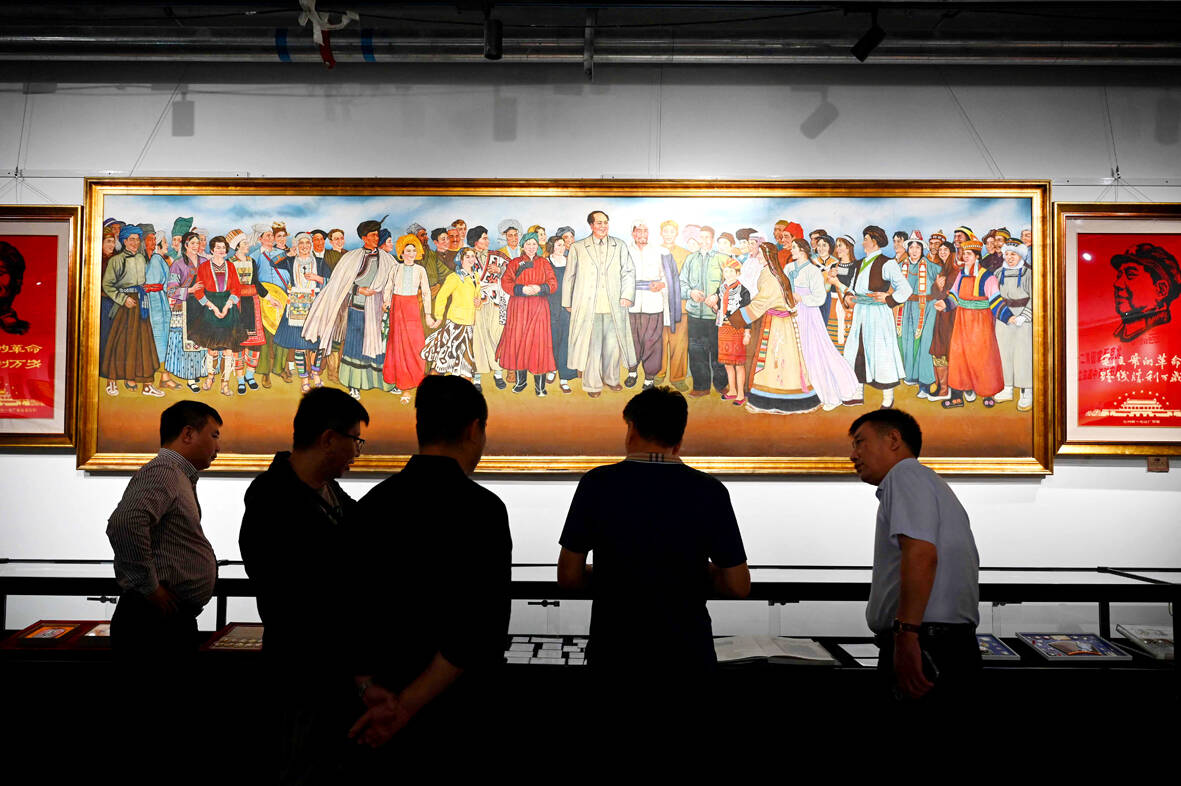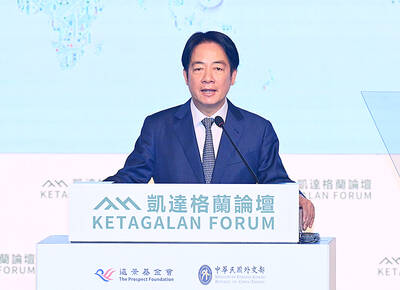His car laden with boxes of brightly-colored communist memorabilia, Feng Gang places one more Chairman Mao (毛澤東) figurine in the back seat then steps back to admire his life’s work.
Feng is one of China’s leading “red collectors,” hoarders of ephemera mass-produced in the country’s turbulent first decades as a communist state up until the death of founding leader Mao Zedong in 1976.
This month, Feng joined hundreds of red collectors in the capital city showing off their wares ahead of the 75th anniversary of the founding of the People’s Republic of China on Oct. 1.

Photo: AFP
“I started to love red collecting in the third grade, starting with one memorial badge of Chairman Mao,” Feng, 53, said at his home in Baotou, Inner Mongolia.
“We had loudspeakers in the countryside at that time,” he said of his youth in the poor, arid northwestern province of Gansu.
Feng was five years old when Mao died, bringing an end to a reign during which tens of millions of people died in brutal political persecution and economic policies that caused mass starvation.
“We could hear people talking about Chairman Mao from the loudspeakers, and we grew up singing The East Is Red,” Feng said, referring to one of China’s most famous revolutionary songs.
Feng continued collecting badges, posters, statues of leaders and everyday items emblematic of the revolution and Mao era throughout a long career in the military.
Now heading a “red culture” sub-branch under the China Association of Collectors, in his retirement, Feng can devote even more time to his passion: promoting patriotic education of the nation’s youth.
“If a citizen lacks conviction and doesn’t love national heroes, the country will be in danger,” Feng said.
RED NOSTALGIA
China has in recent decades witnessed a resurgence of nostalgia for the Mao era — despite its horrors — due in part to its utopian official outlook and fervent patriotic spirit.
In Beijing’s Panjiayuan, a sprawling commercial hub home to the city’s top antiques market, hundreds of collectors from across China convened for an annual celebration of red culture.
Behind glass cases were displayed porcelain portraits bearing Mao’s serene smile and badges once ubiquitous on clothing during his rule.
During the four-day event, enthusiasts and members of the public milled through an upstairs exhibition hall, gazing at the relics and reminiscing on a bygone era.
Dong Zhongchao, 60, said he’d gathered the collectables “from all corners of the country” — and claimed to have been offered 30,000 yuan (US$4,273) for some “one-of-a-kind” items, which he turned down.
“In 30 years, I’ve been to more than 250 places across China, big and small,” he said.
To Dong, the collection reminds him of his youth.
Another visitor, a 55-year-old surnamed Xiao, said he had been coming to the market every year for two decades.
He enjoys smaller nicknacks from the Mao era, like old coins and items bearing images of leaders and national heroes.
He points to one such figure, Men He, a soldier revered as a model communist during Mao’s bloody Cultural Revolution of the 1960s and 70s, as a model for today’s youth.
“What he did for the revolution — a lot of people are unaware of it,” said Xiao.
“Young people should understand this patriotism,” he added, his 28-year-old daughter listening by his side.
‘ENLIGHTENING SOCIETY’
Emily Williams, an expert on Maoist material culture, said that the red collection movement had its roots in the eighties, when sweeping reforms ushered in a new era of rapid economic development.
“For some of the collectors, there was a feeling that if everything was changing so quickly, there was this danger that they would forget the path they had taken in order to get there,” she said.
Many of the collectors are the “children” of the Mao era, she explained.
“They believe in the socialist values that were taught to them at the time,” she said.
Feng, the collector from Inner Mongolia, said it was devotion to his motherland that had driven him across the country in search of relics.
“Basically all my time and energy outside of work were spent on collecting red items,” Feng said.
“(I traveled) all over the country using my annual leave, including holidays. I had no time to spend with my family.”
But he sees his work as a nobler pursuit than the collection of humdrum antiques.
“They have an educational function: enlightening society.”

Following the shock complete failure of all the recall votes against Chinese Nationalist Party (KMT) lawmakers on July 26, pan-blue supporters and the Chinese Communist Party (CCP) were giddy with victory. A notable exception was KMT Chairman Eric Chu (朱立倫), who knew better. At a press conference on July 29, he bowed deeply in gratitude to the voters and said the recalls were “not about which party won or lost, but were a great victory for the Taiwanese voters.” The entire recall process was a disaster for both the KMT and the Democratic Progressive Party (DPP). The only bright spot for

Water management is one of the most powerful forces shaping modern Taiwan’s landscapes and politics. Many of Taiwan’s township and county boundaries are defined by watersheds. The current course of the mighty Jhuoshuei River (濁水溪) was largely established by Japanese embankment building during the 1918-1923 period. Taoyuan is dotted with ponds constructed by settlers from China during the Qing period. Countless local civic actions have been driven by opposition to water projects. Last week something like 2,600mm of rain fell on southern Taiwan in seven days, peaking at over 2,800mm in Duona (多納) in Kaohsiung’s Maolin District (茂林), according to

Aug. 11 to Aug. 17 Those who never heard of architect Hsiu Tse-lan (修澤蘭) must have seen her work — on the reverse of the NT$100 bill is the Yangmingshan Zhongshan Hall (陽明山中山樓). Then-president Chiang Kai-shek (蔣介石) reportedly hand-picked her for the job and gave her just 13 months to complete it in time for the centennial of Republic of China founder Sun Yat-sen’s birth on Nov. 12, 1966. Another landmark project is Garden City (花園新城) in New Taipei City’s Sindian District (新店) — Taiwan’s first mountainside planned community, which Hsiu initiated in 1968. She was involved in every stage, from selecting

As last month dawned, the Democratic Progressive Party (DPP) was in a good position. The recall campaigns had strong momentum, polling showed many Chinese Nationalist Party (KMT) lawmakers at risk of recall and even the KMT was bracing for losing seats while facing a tsunami of voter fraud investigations. Polling pointed to some of the recalls being a lock for victory. Though in most districts the majority was against recalling their lawmaker, among voters “definitely” planning to vote, there were double-digit margins in favor of recall in at least five districts, with three districts near or above 20 percent in